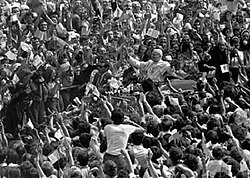Sign of contradiction

In Catholic theology, a sign of contradiction is someone who, upon manifesting holiness, is subject to extreme opposition. The term is adopted from the New Testament phrase "a sign that is spoken against", found in Luke 2:34 and in Acts 28:22, where the texts refer first to Jesus Christ, and then to the early Christians. Contradiction comes from the Latin contra, "against", and dicere, "to speak".
According to Catholic tradition, a sign of contradiction points to the presence of Christ or the presence of the divine due to the union of that person or reality with God. Pope John XXIII referred to the child Jesus as "the sign of contradiction" in his speech at the opening of the Second Vatican Council in 1962, and in his book entitled Sign of Contradiction (1979), Pope John Paul II writes that "sign of contradiction" might be "a distinctive definition of Christ and of his Church".
The cross and mortification as signs of contradiction
Edith Stein, called the Patron of Europe by Pope John Paul II, taught on the day of the Feast of the Exaltation of the Holy Cross, September 14, 1939:
Views on the cross creates divisions: "The division between those whose first love is God, and those whose first love is self – might also be expressed as the division between those who accept the place of the Cross in the following of Christ, and those who reject all sacrifice except it be for personal gain."
The Church and Christians as signs of contradiction
The second biblical phrase is from Acts 28:22, where the writer quotes a Jew in Rome with whom Paul was talking:
According to Catholic theologians and ecclesiologists like Charles Journet and Kenneth D. Whitehead in One, Holy, Catholic, and Apostolic: The Early Church was the Catholic Church, the sect being referred to here by the Jews is the early church of Christians.
The Church and the early Christians, according to these Catholic theologians, are one with Jesus Christ. As an example, they say that when Paul was persecuting the early Church, Jesus Christ appeared to him and said: "Why do you persecute me?"
The passage from the Acts of the Apostles is related to John 15:5–8:
This passage shows the double-movement depending on the two possible attitudes towards Christ: whoever is united to Christ in holiness will rise and bear fruit, while those who are disunited to Christ will fall down and wither.
Pope John Paul II

Sign of Contradiction is also the title of Lenten meditations preached by and written about upon the request of Pope Paul VI by Pope John Paul II. The theme of the book, according to one review, is "the human encounter with God in a world that seems to contradict the reality of divine power and love."[This quote needs a citation] Pope John Paul II says in his conclusion that "It is becoming more and more evident that those words (Luke 2:34) sum up most felicitously the whole truth about Jesus Christ, his mission and his Church."
When Pope John Paul II passed away in 2005, John Cawte on ABC and activist Judie Brown on The Washington Dispatch each described the late Pope himself as a "sign of contradiction".
See also
Endnotes
References
- Wojtyla, Karol. Sign of Contradiction.
- Woods, Thomas. How the Catholic Church Built Western Civilization.
- Quasten, James. Patrology.
- Carrol, Warren. History of Christendom.
- Journet, Charles. The Church.
- Allen, John. Opus Dei: An Objective Look at the Most Controversial Force in the Catholic Church.
- Casciaro, Josemaria, et al. Navarre Bible.
- José Miguel Cejas, Piedras de escandalo
Further reading
- Elio Sgreccia, Vice President of the Pontifical Council for Life."Mons. Sgreccia Inglese". www.vatican.va.